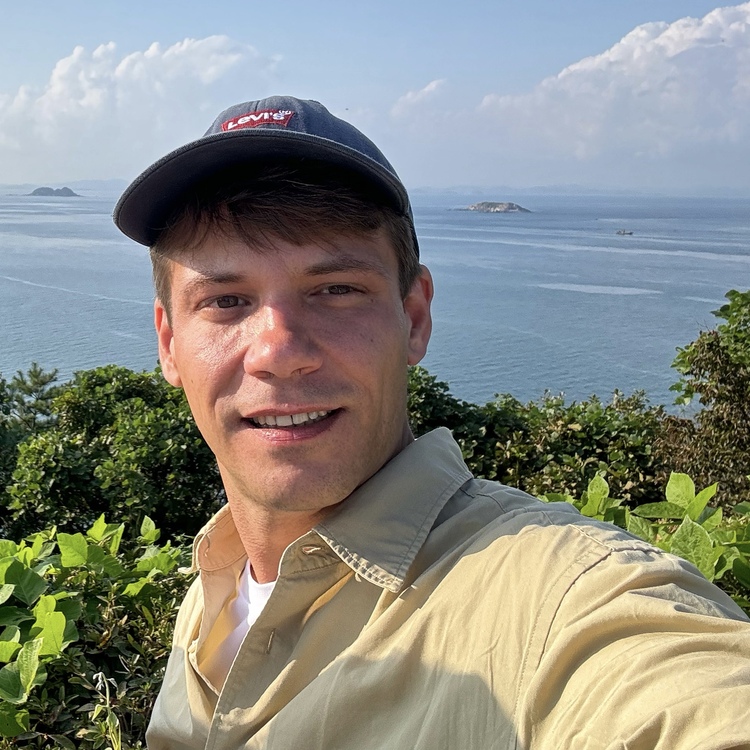Koryo Tours' Greg gives us his account in this blog series of the events leading up to April 27, 2018.
Friday, April 27, 2018, was a busy day at Koryo Tours.
While North Korea and South Korea was just about to reach a new milestone – after an 11–year-long halt – in inter-Korean relations, we were busy making the final preparations for the shooting of Michael Palin in North Korea.
Since February 2018 I have been a “bystander” for the new chapter in the development of inter-Korean relations, becoming a witness of history.
2018 was about the thaw in North-South relations and inter-Korean summits for me, sometimes even causing me troubles.
In the coming two blogs, after an overview of the events leading up to April 27, 2018, I will share my personal experience of the “year of hope” and its aftermath.
The next chapter is yet to be seen…
Inter-Korean Relations After 1953
The Korean War came to an end on July 27, 1953, with an armistice with the result that North Korea and South Korea (or the UN) is technically still at war.
Until the late 1980s, South Korea was ruled by aggressively anti-Communist military dictators and inter-Korean relations were practically non-existent.
Apart from negotiations in 1971-1972, there was no dialogue between the two parts.
In July 1972, however, a Joint Communiqué was issued that stated that both the North and South will work towards a peaceful reunification and some sort of contact was established between the DPRK and the ROK.
In general, until the early 1990s, inter-Korean relations can be described by “hostile coexistence”.
In January 1968, a North Korean commando delivered a failed attempt to raid the South Korean President’s residence, the Blue House. The primary goal of the mission was to assassinate President Park Chung-hee and to blow up the Blue House. The secondary goal was to bomb the US Embassy and the Headquarters of the ROK Army and to free communist prisoners.
North Korean diversionists have also landed on South Korea’s East coast.
The South has also started to train convicts to assassinate Kim Il Sung, however, the project was abandoned amid the 1971-1972 negotiations.
In 1972, North Korea has also started to dig infiltration tunnels under the DMZ – four has been discovered between 1974 and 1990 – today, they are serving as tourist attractions in the South.
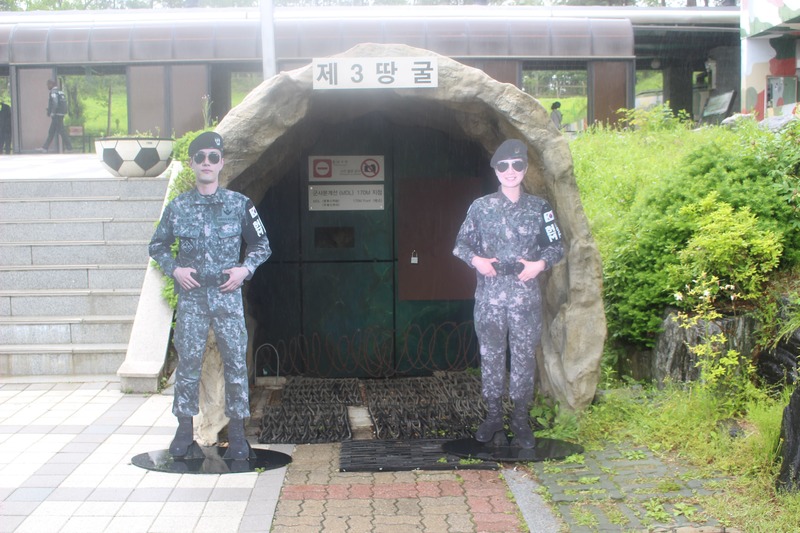
In 1983, there was a second failed assassination attempt carried out, this time against President Chun Doo-hwan in Yangon, Burma.
In 1987, Korean Air flight 858 from Baghdad to Seoul via Abu Dhabi has disappeared over the India Ocean due to bombs installed by North Korean agents.
However, there are some conspiracy theories that actually the South Korean government staged the incident.
In December 1991 a reconciliation, non-aggression and cooperation pact was signed by North and South Korea.
In 1993, Ri In Mo was released by South Korea, followed by the amnesty of non-converted prisoners in 1999, and the release of 33 more prisoners during the 2000 summit.
The First Inter-Korean Summit (2000)
In 1998, a leftist politician, Kim Dae-Jung became the President of the Republic of Korea. Kim Dae-Jung was a political dissent during the rightist's military junta in the 1970s and has also become an icon in North Korea.
During his tenure, inter-Korean relations came to a thaw characterized by considerable improvements in the relations between South and North Korea.
Changes started already in 1998 when economic engagement was encouraged by the Blue House and Hyundai started joint ventures in North Korea and opened up Mt. Kumgang for South Korean tourists.
Chung Ju-Yung, born in North Korea, the founder and chairman of Hyundai event met General Kim Jong Il in 1998.
In 2000, Samsung, LG, and Daewoo also opened joint ventures in North Korea primarily producing for the South Korean market.
On April 8th the same year, an agreement was signed by the representatives of the North and South in Beijing about a summit between the leaders of two parts of the country.
On June 13th the South Korean President landed at Pyongyang’s Sunan Airport and for the first time in history, the leaders of both Koreas met.

On June 15th the 6.15 North-South Joint Declaration was issued;
- In August, family reunions will be organized and political prisoners will be released,
- North and South will work together towards the peaceful reunification of Korea,
- Social, cultural, sport, healthcare, and ecological cooperation will be strengthened.
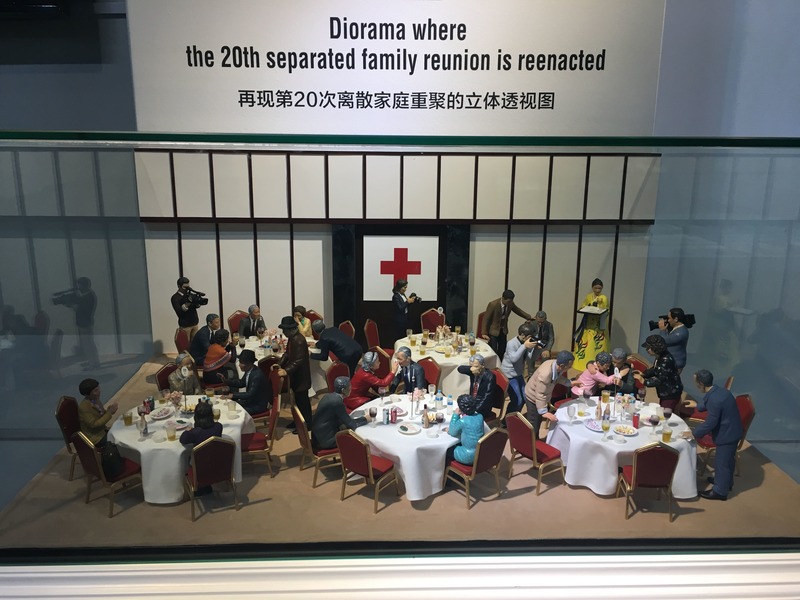
Government-level dialogue has also started, a hotline was established between the North and the South.
The First Inter-Korean summit has brought some international recognition to General Kim Jong Il; in July Putin visited Pyongyang followed by the visit of US Secretary of State Madeleine Albright in October. (Kim Jong Il visited Chinese leader Jiang Zemin in May.)
Kim Dae-Jung received the Nobel Peace Prize "for his work for democracy and human rights in South Korea and in East Asia in general, and for peace and reconciliation with North Korea in particular".
In December 2004, the Kaesong Industrial Zone opened.

In 2006 South Korea suspended its propaganda activity at the DMZ.
In 2007, railway connections between the South and North were reestablished both on the West and the East, however, the railroad was only used between the South and the Kaesong Industrial Zone.
The Second Inter-Korean Summit (2007)
In 2003 Roh Moo-Hyung followed Kim Dae-Jung as the President of the Republic of Korea.
Roh has been known as a lawyer defending pro-Democracy activists in the 1980s and gained his support from the ‘386-generation’ (South Koreans who were in their 30s during the 2002 elections, attended university in the 1980s that was characterized by pro-Democracy student movements, and were born in the 1960s hence the first generation to be born after the Korean War and grew up in a divided Korea).
The Second Inter-Korean Summit took place in October 2007 between General Kim Jong Il and President Roh Moo-Hyung in Pyongyang. President Roh stepped over the DMZ on foot and continued by car to Pyongyang.
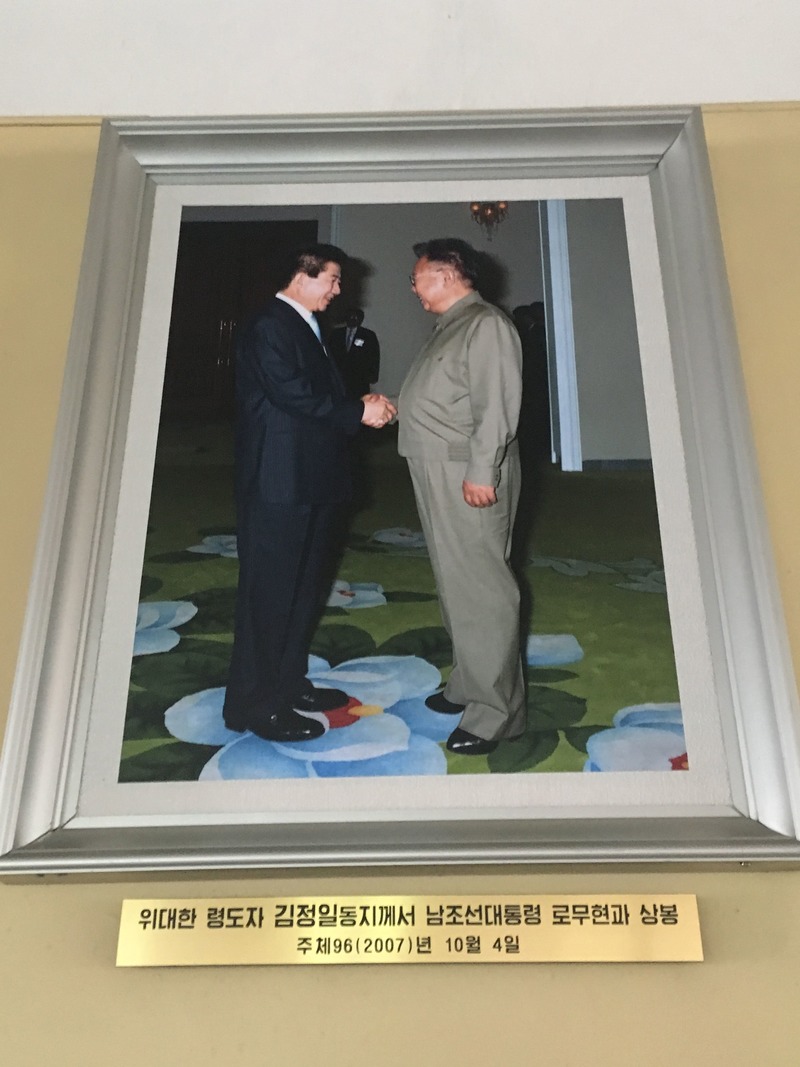
The two leaders reaffirmed their commitment for peace on the Korean Peninsula and economic cooperation.
Kaesong Tours for South Korean tourists have also started after the summit.
The Third Inter-Korean Summit (2018) | Prologue
After a decade of leftist and pro-reconciliation administration in the south, a decade of rightist presidents (Lee Myung-bak, 2008-2013; and Park Geun-Hye, 2013-2017) followed who took a hardline policy towards North Korea.
In 2008, the South resumed propaganda activities along the DMZ. In July of the same year, tours to Mt. Kumgang were suspended after a South Korean tourist lost her life after crossing to a Military Restricted Area and Northern soldier shot her. In November, the North stopped Kaesong city tours.
Tensions grew after the hostile acts of North Korean in the West Sea (Yellow Sea).
In March 2010 North Korean submarines sank a South Korean corvette. 46 South Korean sailors died in the incident.
In November, North Korean artillery shelled Yeongpyeong Island claiming four civilian lives.
In 2013, the Kaesong Industrial Zone closed for five-month, then in 2016 “temporarily” closed again, however, it remains closed at the time of writing in 2020.
Political developments in the South brought new hopes in 2017. Moon Jae-in, the former Chief of Staff and colleague of Roh Moo-hyung was elected president. President Moon’s parents are from Hungnam in the Greater Hamhung area who fled to the South in 1950. President Moon promised a new era of reconciliation during his campaign.
In his 2018 New Year’s speech, Marshal Kim Jong Un announced that he is willing to send a delegation to the Winter Olympics in Pyeongchang.
On February 9th, after twelve years since the 2006 Asian Games, North and South marched together under the Korean Unification Flag at the opening ceremony of the Winter Olympics with the de facto President of North Korea and a member of the North Korean ruling family present.
A North Korean art troupe was also sent to the Olympics and an invitation for visiting North Korea was passed onto President Moon.
I watched the start of the first hockey match of the joint female ice-hockey team of Korea in a Seoul restaurant. To be honest, I didn’t feel that most of the people shared my sentimentalism about the event. Another colleague was present at the event.
On February 11th, when I was flying back to Beijing from Incheon, I spotted the DPRK Government Ilyushin Il-62 parked at a gate at Terminal 1.
On April 1st, South Korean K-pop stars performed in Pyongyang.
The Third Inter-Korean Summit (2018) | 4.27
I woke up early on April 27th. I had to be ready by 5:45 when my DiDi was scheduled to pick me up and take me to Grand Hyatt Beijing where I was meeting a member of Michael Palin’s team to take him to the airport and fly-in to Pyongyang with the filming crew’s equipment.
Unfortunately, I was busy with Chinese Customs and check-in and therefore missed the historic event live. Actually, I haven’t seen any footage of the summit until next day in Pyongyang when the 17:00 News caught me in front of Pyongyang Station.
At 9:30 Seoul time (9:00 Pyongyang time – the two Koreas are still in different time zones for one more week from this day) Marshal Kim Jong Un stepped out Panmun Hall on the Northern side of the Joint Security Area (JSA) and approached the Military Demarcation Line (MDL) where President Moon Jae-in was waiting for him. After a historic handshake, for the first time ever since the Korean War, the leader of North Korea set foot on southern soil by stepping over the MDL followed by a spontaneous invitation for Moon Jae-in to cross over to the North.
According to news reports, President Moon called the Marshal a brave man for stepping over the MDL to which Kim Jong Un responded with the invitation over to the Northern side for a brief step-over hand in hands.
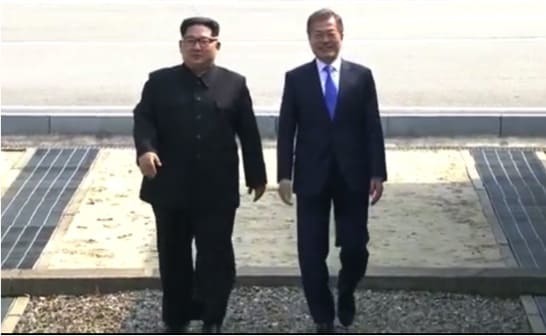
Then, the leaders headed to the Peace House on the southern side of the JSA where Kim Jong Un signed the guest book before the negotiations behind closed doors would commence.
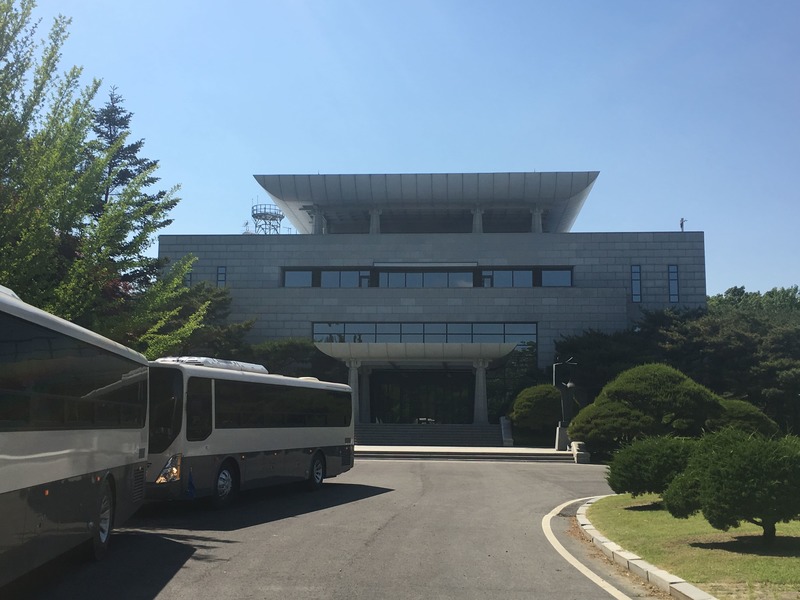
The two leaders had lunch separately, and the summit recommenced after lunch with the (re-)planting of a tree dating back to 1953. The two leaders used soil from the two highest mountain of Korea; from Mt. Paektu in the North and Mt. Halla in the south, watering it with water from the Taedong River in Pyongyang and the Han River in the south.
The memorial stone next to the tree reads: “We plant peace and prosperity”.
The tree-planting ceremony was followed by a walk when the two leaders could talk in private until they headed back to the Peace House to continue the official talks.
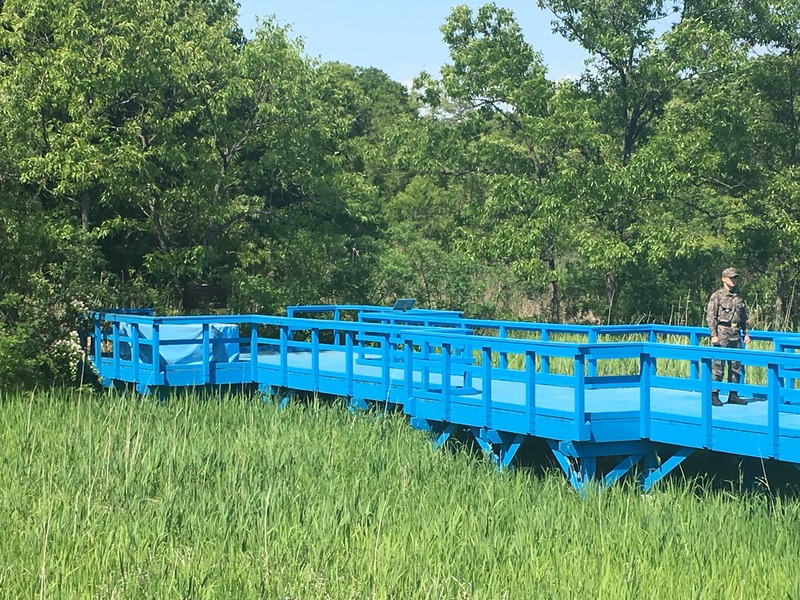
The summit was concluded in the Panmunjom Declaration in which President Moon Jae-in and Marshal Kim Jon Un agreed to work together towards peace and reunification by establishing regular contacts between the two sides, formally ending the Korean War with a peace treaty in place of the armistice agreement, making family reunions possible, reconnecting and modernizing roads and railways connecting the two Koreas, and ceasing all hostile acts.
They also agreed that President Moon will visit Pyongyang in the autumn.
The two leaders had dinner together, the menu included Pyongyang cold noodles that Kim Jong Un brought from Pyongyang: “I saw earlier that the dinner menu here is a very hot topic. I also brought with me cold noodles from Pyongyang so President I hope you can enjoy the Pyongyang noodles.”
The Third Inter-Korean Summit (2018) | Meanwhile in Pyongyang
Our aircraft landed with a two-hour delay in Pyongyang after we had to wait for connecting compatriots from Japan.
Things were like usual at the airport only that customs took ages as we had to go through a dozen of filming equipment for Michael Palin’s crew. You can imagine administrative procedure it involves in North Korea.
Although our guides and colleagues in Korea were aware of the significance of the day in the history of inter-Korean relations, no news was released about the summit.
I happened to be among the first people to report about the 4.27 Summit in Korea and Koreans around me among the first people to learn about some details of the Third Inter-Korean Summit. However, I could only tell what I briefly read in Beijing before our flight could take off. (Koryo Link didn’t show up at Sunan Airport so I couldn’t register my SIM and access the internet.)
The next day we headed out to the outskirts of Pyongyang to shoot the Pyongyang-Beijing train for Palin’s travel documentary and it was not until after lunch that we could go to Pothonggang Hotel to register my phone and learn something more about the summit.
Needless to say, as soon as my SIM was registered and I had access to the internet questions from our guides about the summit flooded me.
Palin’s train was due to arrive at 18:15 but we had to go to Pyongyang Station early to set up the camera to film his arrival to Pyongyang. We arrived at the train station just in time for the 17:00 news which to my best knowledge the first media outlet in North Korea to release footage about the historic summit.
There is a huge public screen on the square in front of Pyongyang Station. Pedestrians stopped, and everyone was watching the news. When Marshal Kim Jong Un stepped over to the South a crowded responded with great ovation and applause. When President Moon stepped over to the North and even louder ovation welcomed this one small step for a man but a giant leap for the Korean Peninsula.
When we entered the station building, to our surprise, no one cared about us. Everyone was watching the television in the waiting room and the newest edition of Rodong Sinmun was placed in the newspaper cabinet.
The joy and excitement was palpable.
In the next chapter of this blog series, we will revisit the two summits between President Moon and Marshal Kim Jong Un that followed the 4.27 Summit and see what has been achieved since then.
